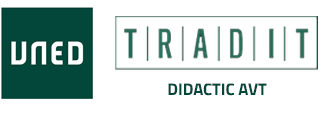
This book offers an updated and comprehensive view of the possibilities of didactic audiovisual translation (didactic AVT or DAT) in language education, by presenting the methodological bases that support its pedagogical use at all levels of linguistic proficiency, as well as in different educational stages and contexts.
The volume defines the main didactic AVT modes, accompanied by general recommendations, specific guidelines, complete sample lesson plans and sequences, and models for assessment. Didactic AVT is described in this book as an effective pedagogical resource that can improve students’ language competence and trigger core factors in education, such as learners’ motivation and engagement in language classes, their cognitive processes, their creativity, and the active use of ICTs in the classroom. From the perspective of educators, DAT provides a pool of multipurpose resources that may help them to enrich their classes from a pedagogical, linguistic and intercultural standpoint.
This book will be a valuable resource for graduate students, scholars, and practitioners in translation studies, particularly those interested in audiovisual translation and foreign language learning.
Contents
Acknowledgement
List of acronyms and abbreviations
Introduction
AVT modes
The need for a volume on DAT
Aims and scope of the book
Copyright considerations
Structure of the book
References
Chapter 1
1.1. Didactic subtitling
1.1.1. Didactic interlingual standard subtitling
1.1.2. Didactic interlingual reverse subtitling
1.1.3. Didactic intralingual subtitling
1.1.4. Didactic creative subtitling
1.1.5. Didactic SDH
1.2. Didactic dubbing
1.2.1. Didactic interlingual reverse dubbing
1.2.2. Didactic intralingual dubbing
1.2.3. Didactic creative dubbing
1.3. Didactic audio description
1.4. Didactic voice-over
1.5. Didactic free commentary
1.6. Teacher training in Didactic Audiovisual Translation
1.7. Closing remarks
References
Chapter 2
2.1. Educational bases of didactic AVT
2.2. Introducing didactic AVT in the language classroom
Primary education
Secondary education
Higher education
Bilingual education: CLIL and EMI
2.3. Didactic AVT applicability to diverse LE contexts
2.4. Closing remarks
References
Chapter 3
3.1. Didactic subtitling types
3.2. Skills enhancement through didactic subtitling
3.3. Didactic SDH
3.4. Didactic subtitling and didactic SDH: guidelines and assessment samples
3.5. Lesson plan samples
3.6. Closing remarks
References
Chapter 4
4.1. Didactic dubbing and didactic voice-over types
4.2. Skills enhancement through didactic dubbing and didactic voice-over
4.3. Didactic dubbing and didactic voice-over guidelines and assessment samples
4.4. Lesson plan samples
4.6. Closing remarks
References
Chapter 5
Didactic Audio Description and didactic free commentary
5.1. Didactic AD and didactic free commentary types
5.2. Skills enhancement through didactic AD and didactic free commentary
5.3. Didactic AD and didactic free commentary guidelines and assessment sample
5.4. Lesson plan samples
5.5. Closing remarks
References
Conclusions
Appendix
Index

Noa Talaván is Associate Professor at the Universidad Nacional de Educación a Distancia (UNED). She has specialized in Didactic Audiovisual Translation as her main research line for the last two decades and coordinates the international research group TRADIT (Didactic Audiovisual Translation) based at the UNED.
Jennifer Lertola is Junior Assistant Professor of English at the University of Eastern Piedmont (Italy). Her research interests include Didactic Audiovisual Translation, English-Medium Instruction, and English for Specific Purposes.
Alberto Fernández-Costales is Associate Professor in TESOL at the University of Oviedo (Spain). Among others, his research interests include Content and Language Integrated Learning, English-Medium Instruction, and didactic audiovisual translation. He serves as an associate editor of Perspectives: Studies in Translation Theory and Practice and Porta Linguarum.
Available order – 2 Chapters in this book are Open Access.
Chapter 2: Educational bases of didactic AVT in FLE
Chapter 5: Didactic audio description and didactic free commentary
